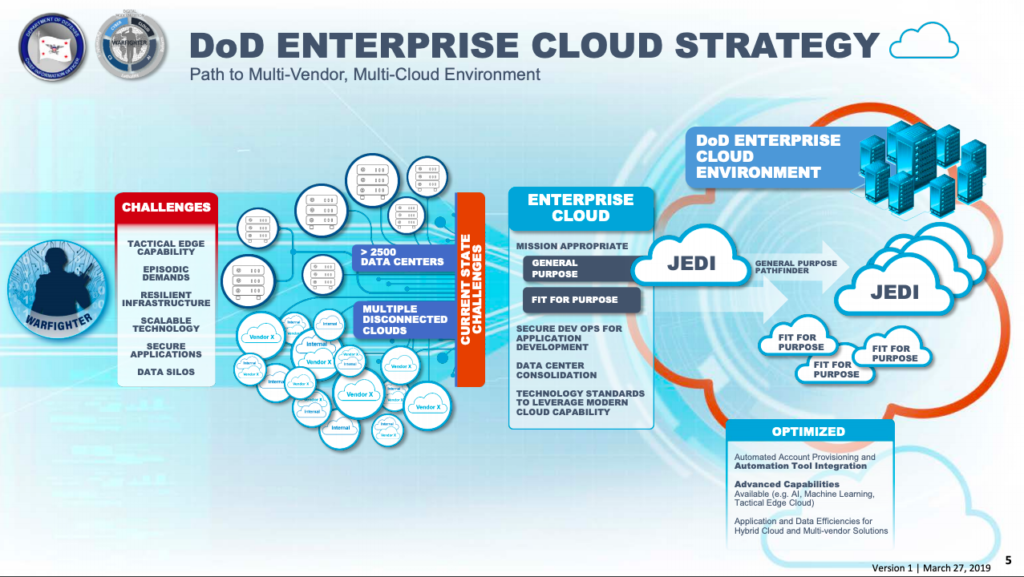
The Pentagon’s plan to consolidate many — but not all — of its 500-plus cloud contracts into a single Joint Enterprise Defense Infrastructure (JEDI).
Pentagon leaders have hungered for years to do more business with innovative technology companies that were scared off by the Defense Department’s labyrinthine acquisition processes. But the so-called JEDI contract to build a global general-purpose cloud for the military was going to be different. The building was going to move smartly to award a contract and make it straightforward and relatively simple.
Then came the criticisms from some of the world’s wealthiest corporations and their leaders: The contract was badly structured; there was favoritism towards Amazon inside the Pentagon; there was bias against Amazon from the White House. It got messy. The mighty brains of Mark Cancian and Andrew Hunter at the Center for Strategic and International Studies try to pick apart what’s next for this program that has attracted so much interest from President Trump. Read on! The Editor.
At first, President Trump’s statements questioning whether Amazon should get a major Pentagon cloud computing contract looked like his usual bluster. But new information indicates that the White House involvement may have gone deeper than mere expressions of opinion.
A recent book by a senior member of former Defense Secretary Jim Mattis’s staff claims the president directed Mattis to “screw Amazon” out of the Joint Enterprise Defense Infrastructure (JEDI) contract. Mattis is alleged to have stated that, “We’re not going to do that. This will be done by the book, both legally and ethically.
That may have been the end of it. On the other hand, it often happens that ambitious and energetic members of the White House staff will push agencies to implement what they think their boss wants.

Mark Cancian
Now that DOD has selected Microsoft as the winner of the JEDI contract, Amazon has initiated legal proceedings to challenge the decision. That process will eventually involve depositions, legal arguments, and, possibly, public statements. In Washington’s politicized atmosphere, the dispute could morph into another avenue for investigating the president. At the least, the nation will get an education in DoD contracting procedures, protections, and protests. Here’s what to watch for.
What is this contract? Joint Enterprise Defense Infrastructure is a multiyear contract for secure cloud computing services that could have a maximum value of $10 billion. The contract would migrate portions of DOD’s computing and data storage out of a disjointed collection of its own hardware and software and into the massive server farms that cloud computing providers operate. It’s a large contract because the military wants to have a highly secure enterprise-wide solution that all of its elements can participate in and, therefore, communicate more effectively with each other. The initial contract guarantees a minimum of two years and $10 million and is slated to begin by transitioning computing resources from DoD’s so-called fourth estate to the cloud. Over time, other parts of DoD may also transition their applications and data to JEDI, particularly those that require the robust security JEDI provides.

Andrew Hunter
The contract was already highly controversial before you even got to the presidential politics. Many other cloud providers such as IBM and Oracle argued that, instead of a single award, the contract should be awarded to multiple vendors who would compete for specific task orders tied to discrete applications and databases to ensure continuing competition. Safra Catz of Oracle was particularly vocal in this regard. [It’s worth noting DoD already has some 500 cloud computing contracts, not all of which JEDI would replace, and even JEDI itself might turn into a multi-vendor program once the Department feels it’s on a solid foundation. — the editors]
On October 25, DOD announced that Microsoft had won the contract. Although Amazon is the industry leader in terms of market share, Microsoft is a credible competitor that was able to satisfy the stringent security requirements established by the government. Contracts of this magnitude often are protested by the losing side, but normally the focus of the protest is on fairly technical matters, and the matter would likely have been quickly adjudicated. The story might have ended in this low-visibility bureaucratic process except for President Trump’s involvement.
Why did Trump get involved?
The president was made aware of allegations from Amazon’s competitors before the contract award. These allegations claimed certain elements in the Pentagon with connections to Amazon designed the JEDI competition in the company’s favor. After the Court of Federal Claims reviewed these claims and decided to allow the competition to proceed, the same claims were presented to Congress and, eventually, to President Trump, although they had been dismissed by a court of law.
Further, President Trump hates Amazon and its leader, Jeff Bezos. Back in 2013, Bezos bought the ailing Washington Post. It was a “vanity acquisition,” similar to others that billionaires were making at the time to increase their presence outside of their technical fields. However, the Post editorial board’s vehement opposition to many of the president’s policies has thrust the paper and its owner into the president’s sights.
Other media outlets have similarly published opposition to many of the president’s policies, but the Post is the president’s hometown newspaper and therefore gets oversized attention.
How did the White House get involved?
The president, citing concerns about creating a monopoly, directed the Defense Department last summer to review the JEDI approach. Newly confirmed Defense Secretary Esper agreed. Nothing has been announced about the results of this review, even though the contract was allowed to move forward. However, there may have been more going on in this regard.
Why is this a problem?
There are different stages of the contracting process that present different risks for interference. In particular, there’s a critical difference between source selection and contract negotiations. Source selection is the process by which DOD decides which company will get a particular contract. The source selection process is rigorously protected from outside interference. This allows a credible and objective process providing the best value to DOD, the government and, ultimately, to the taxpayers.
Source selection on a major contract is done by a source selection authority, whose identity is often kept confidential to minimize the possibility of improper influence. The winner is decided on the basis of an evaluation by a source selection evaluation board composed of subject matter experts who score the various bids submitted according to preestablished evaluation criteria. These criteria have been publicly vetted before bids are received to ensure that they are appropriate. For large contracts, the source selection evaluation board’s work is also reviewed by a source selection advisory council. In this manner, sources selections for major contracts are effectively triple ring-fenced to keep out improper influence.
White House interference in the inner workings of a source selection process would be a serious transgression. The fact that an impression has already developed that the White House influenced the contract award has already caused damage to the process’s reputation for integrity.
Contract negotiations occur after a source has been selected, and the government is establishing the terms and conditions of the agreement. Contract negotiations establish terms such as how much profit the contract allows and how extensive the scope of work on the contract will be. The contracting process protects against outside interference by empowering warranted contracting officers to be the final authority on contract terms, but these terms are reviewed and can be revised by more senior officials who ultimately report to the President.
The president has periodically inserted himself into contract negotiations, for example, by calling for price reductions on the F-35 Joint Strike Fighter program and the next version of Air Force One, known as the Presidential Aircraft Replacement program. Although presidential involvement is unusual, there’s nothing necessarily illegal about it and, if the president helps to get taxpayers a better deal, that’s all to the good.
So, what happens next?
Amazon has filed a bid protest with the Court of Federal Claims, which happens to be located on Lafayette Square, right next to the White House. Amazon decided not to lodge a protest with the Government Accountability Office, which has authority to review source selections and reviews about 2,000 per year. GAO reviews many more bid protests than the Court of Federal Claims, but ultimately, they both have jurisdiction, and it is up to the claimant to choose whether to file a bid protest with one or both. However, GAO has a somewhat narrower set of source selection issues it reviews, and its bid protest decisions are only advisory.
While DoD almost always complies with GAO’s decisions, Amazon may have wanted the stronger authority of a court order. In filing the protest with the Court of Federal Claims, Amazon argued that: “Numerous aspects of the JEDI evaluation process contained clear deficiencies, errors, and unmistakable bias—and it’s important that these matters be examined and rectified.”
The court will first establish if it has jurisdiction and whether Amazon has standing to protest. Both are givens in this case. It will request the Justice Department to appoint an attorney to represent the government and may accept Microsoft intervening in the lawsuit on the government’s side since it is directly affected. Amazon will identify the issues it believes the court should review in its complaint.
Amazon is also likely to seek an injunction keeping the government and Microsoft from moving forward with the contract while the case is pending.
DOJ will then file an administrative record detailing the source selection process and why the government decided to award the contract to Microsoft. After reviewing that record, Amazon has a chance to amend its complaint and submit a written response to the government showing why it believes the source selection should be overturned. The government and Microsoft then have an opportunity to respond. The court will likely also hear oral arguments before deciding the case. The entire process generally takes 100 days or more and thus may well drag on beyond the completion of the House impeachment inquiry.
DoD’s Chief Information Officer Dana Deasy has argued that he kept the identity of the source selection authority and the other source selection team members strictly confidential so there couldn’t be any improper influence brought to bear upon them. However, if the bid protest were to find evidence of improper influence, the contract would probably be overturned, and evidence of improper behavior turned over to other federal authorities to investigate. Conceivably, such details could come out during the Senate impeachment trial, assuming the House votes to impeach. Almost certainly, they would be a feature of the next presidential election. Stay tuned.
Mark Cancian, a member of the Breaking Defense Board of Contributors, was a senior official at the Office of Management and Budget before he joined CSIS. Andrew Hunter was chief of staff to Ash Carter and Frank Kendall, while they served as undersecretary of defense for acquisition, so he knows acquisition.
Australia unveils ‘historic’ defense boost to 2.4% of GDP in decade, but critics say too little, too late
Part of the shakeup includes tens of billions for nuclear-powered subs, and halting the pricey procurement of an additional F-35 fighter jet squadron.



























